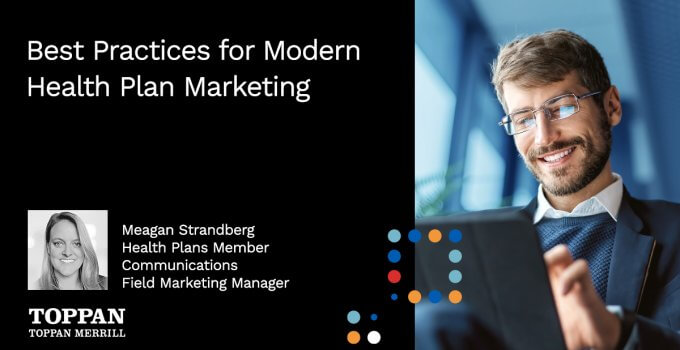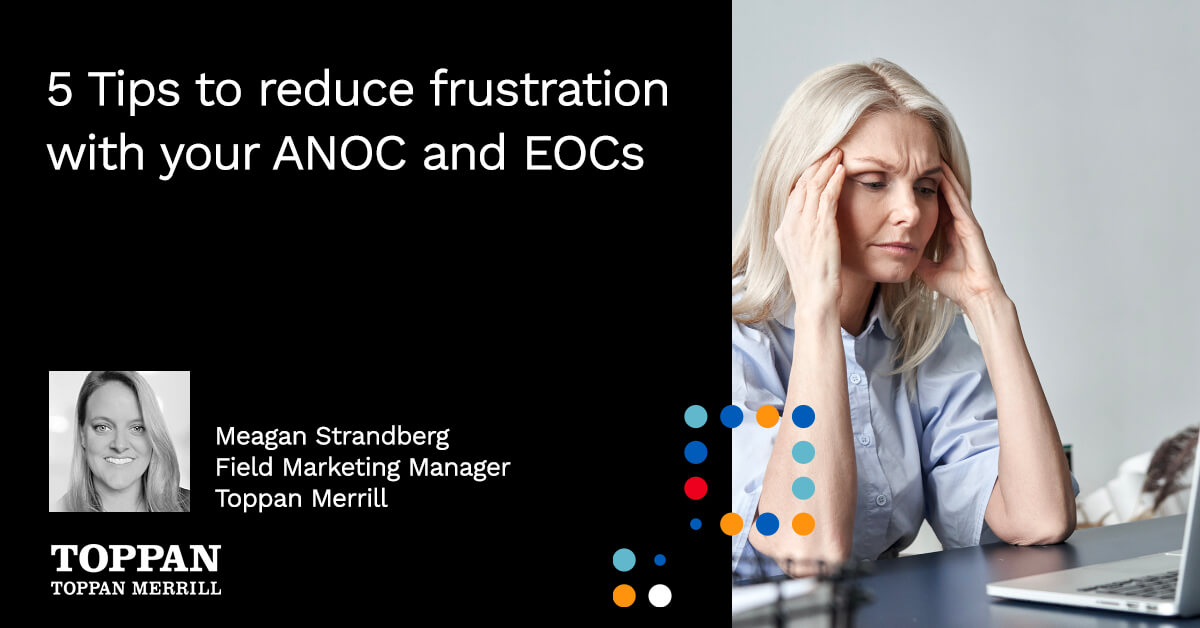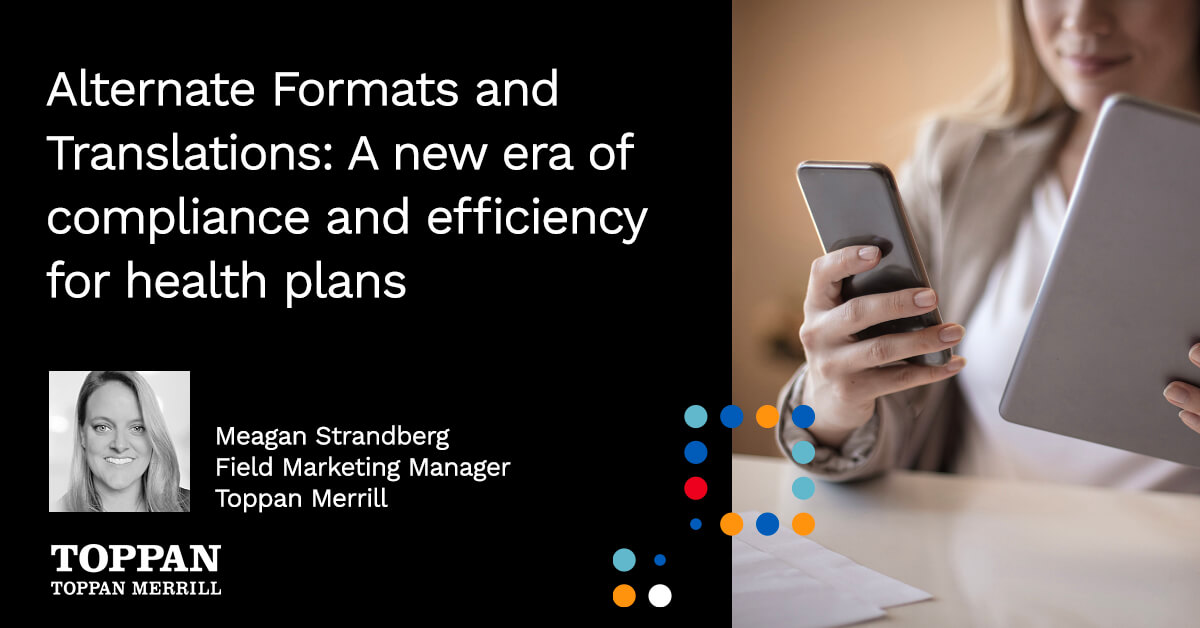Health plans today face unprecedented competition, ever-changing regulations, and soaring member expectations that all demand a new approach to engagement. Core to this new approach is elevating the role of health plan marketing, moving it beyond traditional campaigns to become a central orchestrator of the entire member journey. But how can marketing effectively integrate into this complex puzzle, especially when dealing with compliance-heavy deliverables like Annual Notice of Changes (ANOCs) and Evidence of Coverage (EOCs)?
Why health plans are seeking best practices
Health plans are currently facing significant pressure on multiple fronts. CMS regulations continue to evolve, creating a “moving target” for Medicare Advantage Organizations (MAOs). The competitive market for health plans is also heating up, with more payers offering a wider variety of plans. Simultaneously, members have higher expectations for personalized, digital-first experiences, similar to what they receive from other consumer brands.
This shift towards value-based care and personalized outreach necessitates tighter cross-team workflows. Recent CMS Final Rules focus on making member communications accessible. They require materials to be in accessible formats.
They also need to use the language of the population if they meet a certain language threshold. Once a member asks for a specific delivery format, the plan must keep providing content in that format forever. This is a significant change from the old rules.
These changes create new logistical challenges for health plans. They require a proactive approach to manage different delivery methods. This may push current delivery partners beyond what they can handle.
Marketing’s role in health plan operations
Leading health plan organizations are expanding and elevating the role of marketing, from shaping brand identity and driving acquisition strategies to managing retention communications and member engagement journeys. Marketing teams are responsible for creating targeted campaigns, personalizing health plan solutions, enhancing member onboarding experiences, optimizing websites and digital channels, and improving member support.
ANOCs and EOCs present vital member engagement opportunities
Annual communications like ANOCs and EOCs present vital opportunities for member engagement. Ownership of these regulatory documents has traditionally been centralized within compliance. But more top health plans are bringing marketing into help enhance these regulatory documents and make the most of them as touchpoints in the member journey. This marketing involvement ensures these critical documents are not only compliant but also clear, accessible, and aligned with the overall member experience strategy.
However, this also introduces new complexities. Savvy marketing teams want to aggregate and analyze member data to deliver the hyper-personalized communications and experiences that earn engagement and loyalty. Still, health plans need to navigate this data utilization while maintaining strict compliance with data privacy regulations. The integration of separate systems and processes between compliance and marketing teams is key to success. However, this integration must follow strict regulatory guidelines.
Let’s explore some of these complexities. A shared responsibility model or a centralized approach can help. Strong collaboration among marketing, compliance, and legal teams is key. This can improve engagement, protect compliance, and ensure accuracy and timely delivery.
Tackling nonconforming workflows
Nonconforming workflows happen because of different systems and isolated departmental processes. This leads to problems like duplicate data entry, inconsistent document approvals, and no clear view of member interactions. This fragmentation can hinder a health plan’s ability to respond quickly to regulatory changes and member needs.
A best practice for health plans is to establish cross-functional workflow maps that clearly delineate responsibilities and touchpoints for all member communications, especially for regulated documents. This involves evaluating translation workflows, document generation systems, and mailing processes for non-standard formats.
It is important to have strong quality assurance (QA) and version control systems. This helps ensure accuracy and compliance. This is especially true for marketing-regulated documents like ANOCs and EOCs.
Marketing can ensure that even complex communications focus on members. They should be clear and easy to understand. This means proactively informing members about the availability of translated materials and alternate communication formats.
Smart data integration: The backbone of effective health plan marketing
Health plans often grapple with siloed data across various platforms, including CRM, eligibility, claims, and engagement systems. This fragmentation prevents a holistic view of the member and limits the ability to deliver personalized experiences.
Creating a unified member profile is best. You can achieve this by creating a central place to manage and access all member preferences. This “single source of truth” guarantees that all communication channels and systems apply preferences consistently.
Working closely with IT and data governance teams from the start is important. This helps ensure secure and HIPAA-compliant data integration.
Unified data enables powerful use cases:
- Personalization in chronic condition outreach is important. Predictive modeling can find at-risk individuals. It can also give personalized suggestions for prevention and chronic care. These insights rely on data.
- Reducing outreach fatigue: Health plans can learn about members’ preferred communication channels. This helps avoid sending too many irrelevant messages. As a result, engagement improves and costs go down. AI tools can further enhance personalization by analyzing individual health data and historical claims to provide tailored plan recommendations and proactive communications.
Leveraging data science for smarter campaigns
Data science, particularly predictive analytics and machine learning is transforming health plan marketing. Health plans can look at member health data to find patterns.
This helps them spot members at greater risk for bad health outcomes. They can then act before problems arise. This also includes using predictive modeling to keep members and gain new ones. It helps identify risks of losing members and customize outreach to stop them from leaving.
Segmentation and behavioral modeling allow health plans to understand and deliver on each member’s unique preferences around communication channels and other alternate delivery formats. This can lead to a fully personalized omnichannel experience, delivering the right information through the right channel.
Cross-departmental collaboration between marketing and data science teams is key to success. Marketing provides insights into member needs and campaign objectives, while data science provides the analytical capabilities to extract actionable insights.
Common pitfalls include misaligned KPIs, where marketing and data science objectives aren’t in sync, and a lack of marketing-friendly dashboards that translate complex data into easily digestible insights for campaign optimization.
Health plans are increasingly using AI chatbots for real-time member support, providing coverage details and claim status, which can lead to significant reductions in member service costs.
Getting started: Actionable recommendations
- Conduct a workflow audit for ANOC/EOC production: Thoroughly examine every interaction point to identify opportunities for capturing language and preferred communication format preferences, validating system functionality, and reviewing all correspondence.
- Build a cross-functional governance group (Marketing, Compliance, IT, Data): Establish a dedicated committee with representatives from each team managing member communications to ensure consistent understanding and application of new regulations and to foster collaboration.
- Prioritize data unification projects with measurable marketing use cases: Focus on creating a single, central repository for member preferences and connecting analytics applications to specific business objectives that drive value.
- Initiate a data science pilot with a narrow, high-impact focus (e.g., churn risk modeling): Start small, building a solid base of aggregated data and identifying specific analytics use cases that align with top-level business objectives to realize significant business value.
Marketing must orchestrate the member experiences of tomorrow
The health plan of the future will be integrated, member-centric, and data-enabled. Marketing’s role is expanding beyond traditional creative functions to orchestrating member experiences and driving measurable outcomes.
It’s crucial for health plans to evaluate their current workflows and determine if they are enabling or hindering marketing effectiveness. Embracing digital transformation and leveraging data will be key to standing out in a competitive market and achieving sustainable growth.
How Toppan Merrill can help
At Toppan Merrill, we understand the complexities of member communications. We work with all types of data formats and are familiar with tight SLAs and quick updates to model document changes. We would be delighted to discuss the automation of your member communications with you.
We provide top solutions for document creation, management, sales support, and more. Our services help you quickly adapt to changes in rules, member needs, and markets. We help health plans create and improve member engagement programs. We use member data to make communications better and more efficient.



